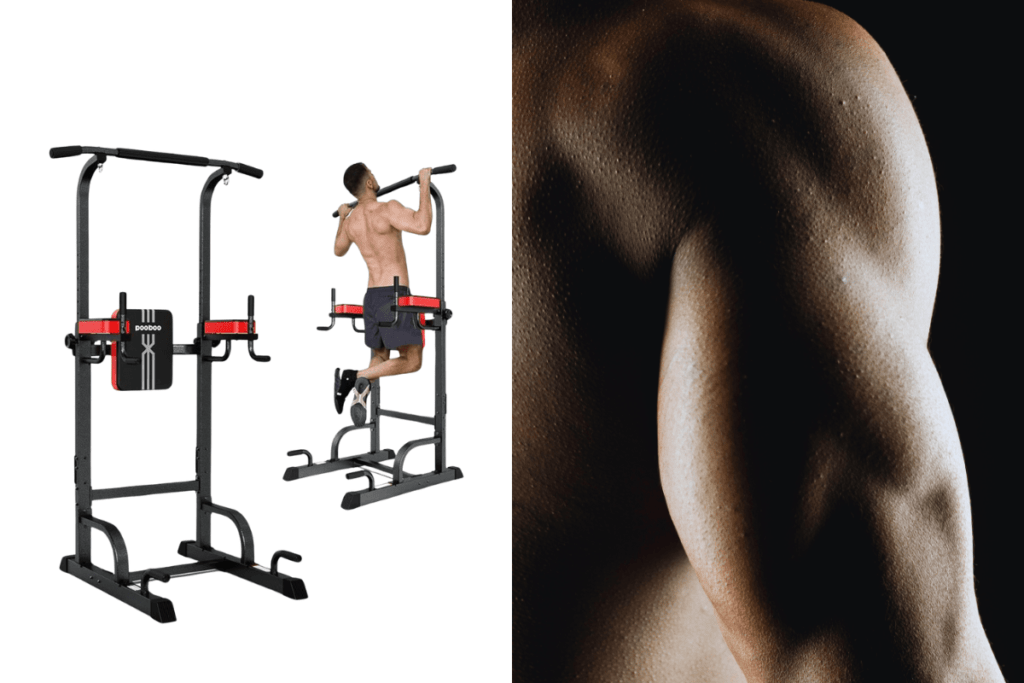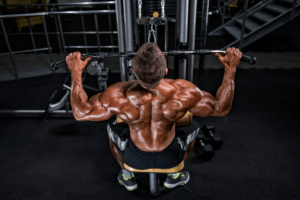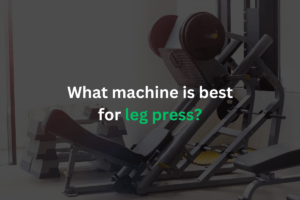Using your weight as resistance, a power tower may be a useful and adaptable tool for working out different muscle groups while building muscle. Power towers themselves don’t come in a lot of different varieties, but some differ according to features and functionality. Power towers are multipurpose stations that let you work out with your body weight in different ways. Below is a summary of the prevalent variations:
- Basic Power Tower: This is the most common type and features a pull-up bar, dip bars, and vertical knee raise station.

- Advanced Power Tower: These towers may include additional features like push-up handles, weight attachments, and an adjustable backrest for decline exercises.

- Wall-Mounted Pull-Up Station: This is a space-saving option that mounts directly to the wall and typically only offers a pull-up bar and dip bars.

Here’s a comprehensive guide on using a power tower to successfully gain muscle:
Understanding the Power Tower:
A power tower typically consists of several stations, including pull-up bars, dip bars, push-up handles, and sometimes leg-raise and vertical knee-raise stations. Each of these stations targets different muscle groups.
- Pull-up bars: Experiment with various grips (wide, narrow, neutral) to target different parts of your back and arms. For example, a wide grip emphasizes the lats while a narrow grip emphasizes the biceps.
- Dip bars: Adjust the width of your grip to target different areas of the chest and triceps. Wider grips emphasize the chest, while narrower grips target the triceps.
- Push-up handles: Elevating your hands on the push-up handles increases the range of motion and emphasizes the chest muscles.
- Vertical knee raise station: Explore different variations such as straight leg raises, bent knee raises, and side-to-side knee raises to target different areas of the abdominal muscles.
Set Your Goals:
Before starting any workout regimen, it’s important to define your goals. Determine specific, measurable, achievable, relevant, and time-bound (SMART) goals for muscle building. For example, aim to increase muscle mass by a certain percentage within a set timeframe.
Warm-Up:
Begin your workout with a dynamic warm-up to increase blood flow to your muscles and prepare your body for exercise. This can include light jogging, jumping jacks, arm circles, and leg swings. Spend 5-10 minutes performing dynamic movements such as jumping jacks, arm swings, leg swings, and bodyweight squats. This prepares your muscles, joints, and cardiovascular system for the upcoming workout.
Basic Exercises:
- Pull-Ups/Chin-Ups: These exercises primarily target your back, biceps, and forearms. Grip the pull-up bar with your hands slightly wider than shoulder-width apart for standard pull-ups or with a narrow grip for chin-ups. Pull yourself up until your chin passes the bar, then lower yourself back down with control.
- Dips: Dips primarily work your chest, triceps, and shoulders. Grab the dip bars with your palms facing inward. Lower your body until your elbows are at a 90-degree angle, then push yourself back up.
- Push-Ups: While not performed on the power tower itself, push-ups are an excellent bodyweight exercise to target your chest, shoulders, and triceps. Place your hands slightly wider than shoulder-width apart, keep your body in a straight line from head to heels, and lower your chest towards the ground before pushing back up.
- Leg Raises/Knee Raises: These exercises target your abdominal muscles (rectus abdominis and obliques). Hang from the vertical knee raise station and lift your legs until they are parallel to the ground. For knee raises, bend your knees and bring them towards your chest.
- Pay attention to tempo (the speed at which you perform each repetition) to maximize muscle activation and control. Experiment with different tempos, such as slow eccentric (lowering) phases and explosive concentric (lifting) phases.
- Utilize isometric holds at various points in the range of motion to increase time under tension and stimulate muscle growth.
Progressive Overload:
To continue building muscle, progressively increase the intensity of your workouts over time. This can be achieved by adding more repetitions, increasing the number of sets, or incorporating advanced variations of exercises. Gradually increase the difficulty of your workouts to stimulate muscle growth. For pull-ups and dips, consider using a weight belt or resistance bands to increase resistance once bodyweight exercises become too easy. Experiment with advanced variations of exercises, such as weighted pull-ups or explosive push-ups, to challenge your muscles in new ways.
Rest and Recovery:
Allow your muscles time to recover between workouts. Aim for at least 48 hours of rest for each muscle group before targeting them again. During rest periods, prioritize sleep, proper nutrition, and hydration to support muscle growth and repair Consider incorporating deload weeks or active rest days into your training schedule to allow your body to recover fully and prevent overtraining.
Nutrition:
Ensure you’re consuming enough calories and nutrients to support muscle growth. Focus on a balanced diet that includes lean proteins (such as chicken, fish, tofu, and beans), complex carbohydrates (whole grains, fruits, and vegetables), healthy fats (nuts, seeds, avocado), and sufficient hydration. Aim to consume protein-rich meals or snacks within 30-60 minutes post-workout to support muscle repair and growth.
Variety and Consistency:
Incorporate a variety of exercises into your routine to target different muscle groups and prevent plateaus. Consistency is key to seeing progress, so aim to work out regularly and gradually increase the intensity of your workouts.
Form and Technique:
Focus on maintaining proper form and technique during each exercise to prevent injury and maximize muscle engagement. If you’re unsure about your form, consider working with a certified personal trainer or fitness professional.
Track Your Progress:
Keep track of your workouts, including the exercises performed, sets, reps, and weights used, and any additional notes. Tracking your progress allows you to identify areas for improvement and adjust your workouts accordingly.
Mind-Muscle Connection:
- Focus on establishing a strong mind-muscle connection during each exercise. Visualize the target muscle working throughout the movement and concentrate on contracting it fully.
- Experiment with different cues and mental imagery to enhance your connection with specific muscle groups. For example, imagine pulling your elbows down and back during pull-ups to engage the lats more effectively.
Eccentric Emphasis:
- Emphasize the eccentric (lowering) phase of each exercise to maximize muscle damage and stimulate growth. Control the descent of your body during pull-ups, dips, and push-ups, resisting gravity rather than allowing gravity to pull you down quickly.
- Incorporate eccentric-focused variations of exercises, such as slow negatives or eccentric isometrics, to further challenge your muscles and promote hypertrophy.
Muscle Activation Techniques:
- Utilize pre-activation techniques to improve muscle recruitment and engagement before performing compound exercises on the power tower. For example, perform band pull-apart or scapular retractions to activate the muscles of the upper back before pull-ups.
- Incorporate isolation exercises or activation drills for specific muscle groups to address weaknesses or imbalances that may hinder performance on compound movements.
Time Under Tension (TUT):
- Manipulate the tempo of your repetitions to increase time under tension and stimulate muscle growth. Experiment with different tempos, such as a 2-1-2 tempo (2 seconds concentric, 1-second pause, 2 seconds eccentric), to prolong the duration of muscle contraction.
- Implement isometric holds at various points in the range of motion to extend TUT and challenge your muscles in different ways. For example, pause at the bottom of a dip or pull-up to increase intensity and activate stabilizing muscles.
Recovery Strategies:
- Explore various recovery modalities to enhance recovery between workouts and reduce the risk of overtraining. This could include massage therapy, contrast hydrotherapy (alternating between hot and cold water immersion), or active recovery activities such as yoga or swimming.
- Invest in quality sleep hygiene practices to optimize recovery and promote muscle repair. Aim for 7-9 hours of uninterrupted sleep per night and establish a consistent sleep schedule to align with your training routine.
Periodic Assessments:
- Regularly assess your strength, mobility, and muscular imbalances to identify areas for improvement and adjust your training program accordingly.
- Conduct periodic form checks or movement assessments to ensure proper technique and address any movement dysfunctions or compensations that may develop over time.
Mindset and Motivation:
- Cultivate a positive mindset and set realistic expectations for your progress. Focus on the process of improvement rather than fixating solely on results, and celebrate small victories along the way.
- Stay motivated by setting short-term goals and milestones, seeking out social support from training partners or online communities, and engaging in activities that bring you joy and fulfillment outside of the gym.
Exercise Variation:
- Continuously vary your exercises to prevent adaptation and promote continuous muscle growth. Rotate between different grip widths, hand positions, and exercise variations to target muscles from different angles and stimulate new muscle fibers.
- Experiment with advanced variations such as muscle-ups, typewriter pull-ups, weighted dips, and plyometric push-ups to challenge your muscles in unique ways and promote further adaptation.
Incorporate Eccentric Overload:
- Integrate eccentric overload training techniques to further stimulate muscle growth. Utilize resistance bands, weight vests, or partner assistance to increase the resistance during the eccentric phase of exercises such as pull-ups and dips.
- Perform accentuated eccentric repetitions by emphasizing the lowering phase of the movement with a heavier load than you can lift concentrically. This eccentric overload can induce greater muscle damage and stimulate hypertrophy.
Mindful Breathing and Core Engagement:
- Practice mindful breathing techniques to enhance intra-abdominal pressure and stabilize your core during exercises. Take a deep breath in before initiating the movement, brace your core, and exhale forcefully during the concentric phase to enhance power output.
- Focus on engaging your core muscles throughout each exercise to improve overall stability and protect your spine. This can help prevent lower back pain and improve performance on compound movements like pull-ups and dips.
Utilize Progressive Calisthenics:
- Embrace the principles of progressive calisthenics to continuously challenge your muscles and progress towards advanced bodyweight movements. Start with basic variations of exercises and gradually increase the difficulty by manipulating leverage, range of motion, or adding external resistance.
- Follow structured progressions for key bodyweight exercises such as pull-ups, dips, and push-ups. Gradually work towards achieving milestones such as one-arm pull-ups, handstand push-ups, and planche push-ups as you develop strength and proficiency.
Integrate Mobility and Flexibility Training:
- Incorporate mobility and flexibility exercises into your routine to improve joint range of motion and movement quality. Addressing mobility restrictions can enhance exercise performance, reduce the risk of injury, and promote optimal muscle activation.
- Include dynamic stretches, mobility drills, and myofascial release techniques such as foam rolling to target tight muscles and improve tissue quality. Prioritize areas of tightness or restriction specific to your individual movement patterns and training goals.
Mindful Recovery Practices:
- Implement active recovery strategies such as low-intensity cardio, yoga, or tai chi to facilitate recovery and promote relaxation. These activities can enhance blood flow, reduce muscle soreness, and improve overall recovery between intense training sessions.
- Practice stress management techniques such as meditation, deep breathing exercises, or progressive muscle relaxation to mitigate the negative effects of chronic stress on recovery and performance. Prioritize mental well-being alongside physical recovery to optimize overall health and fitness outcomes.
Address Weak Links and Imbalances:
- Identify and address weak links or muscle imbalances that may limit your performance or increase the risk of injury. Incorporate unilateral exercises, corrective drills, and targeted accessory work to strengthen weaker areas and restore balance within your musculoskeletal system.
- Consult with a qualified fitness professional or physical therapist to assess movement patterns, identify asymmetries, and develop a targeted plan to address underlying weaknesses or imbalances. A balanced approach to training can improve overall performance and reduce the likelihood of injury over time.
Periodize Your Training Program:
- Implement a structured periodization model to systematically manipulate training variables and optimize muscle growth over time. Periodization involves dividing your training into distinct phases, each with specific goals and training focuses, such as hypertrophy, strength, and power.
- Utilize different training modalities, rep ranges, and intensity levels within each phase to provide sufficient stimulus for muscle adaptation while managing fatigue and avoiding overtraining. Adjust training volume, frequency, and intensity based on individual response and recovery capacity to maximize long-term progress and minimize the risk of injury.
Utilize Isolation Exercises:
While compound movements like pull-ups and dips are excellent for targeting multiple muscle groups simultaneously, incorporating isolation exercises can help you target specific muscles more directly. For example, include exercises like bicep curls, tricep extensions, or lateral raises using resistance bands or dumbbells to isolate and strengthen individual muscle groups.
Focus on Time-Efficient Workouts:
If you have limited time for your workouts, focus on compound exercises that engage multiple muscle groups simultaneously. Compound movements not only maximize muscle activation but also provide cardiovascular benefits, making them efficient choices for time-constrained individuals.
Implement Drop Sets:
Drop sets involve performing a set of exercises to failure or near failure, then immediately reducing the weight and continuing for additional repetitions without rest. This technique helps to induce muscle fatigue and metabolic stress, promoting muscle growth. For example, after completing a set of pull-ups to failure, immediately switch to a resistance band for assistance and continue performing more repetitions.
Use Proper Gripping Techniques:
Pay attention to your grip during exercises like pull-ups and dips. Experiment with different grip widths and hand placements to target various muscle groups more effectively. Additionally, ensure you have a secure grip to prevent slipping and potential injury. Consider using chalk or gloves if necessary to improve grip strength and stability.
Incorporate Plyometric Exercises:
Plyometric exercises involve explosive movements that require rapid stretching and contracting of muscles, helping to improve power and athleticism. Incorporate exercises like plyometric push-ups, clap pull-ups, or explosive dips to enhance muscle activation and stimulate fast-twitch muscle fibers, which are crucial for muscle growth and strength development.
Monitor and Adjust Your Training Volume:
Pay attention to your training volume (sets x reps x weight) and adjust it based on your recovery capacity and goals. Gradually increase volume over time to promote muscle growth, but be mindful of overtraining, which can lead to fatigue, decreased performance, and increased risk of injury. Listen to your body and incorporate deload weeks or periods of reduced intensity to allow for adequate recovery.
Utilize Functional Movement Patterns:
Incorporate functional movement patterns into your workouts to improve overall athleticism and functional strength. Exercises like bodyweight rows, hanging leg raises, and L-sits challenge stability, coordination, and core strength, enhancing your ability to perform everyday activities and sports movements more effectively.
Practice Mindfulness and Focus:
Approach each workout with intention and focus on the quality of your movements. Concentrate on engaging the target muscles throughout the entire range of motion and avoid using momentum or compensatory movements to cheat on exercises. Practicing mindfulness during workouts can enhance muscle activation and promote better mind-muscle connection, leading to more effective muscle growth and development
Periodic Reassessments and Adjustments:
Regularly reassess your training program, goals, and progress to ensure you’re on track to achieve your desired outcomes. Make adjustments to your workouts, nutrition, and recovery strategies as needed based on your response and feedback from your body. Stay flexible and open-minded, and be willing to adapt your approach to maximize results over time.
Seek Professional Guidance When Needed:
If you’re unsure about proper technique, programming, or progression, don’t hesitate to seek guidance from qualified fitness professionals, such as personal trainers or strength coaches. They can provide personalized recommendations, correct form errors, and help you design an effective and safe workout plan tailored to your specific needs and goals.
In conclusion,
by incorporating these additional techniques into your power tower workouts, you can further enhance your strength, muscle growth, and overall fitness levels. Remember to prioritize proper form, moderate overload, and adequate recovery in order to get optimal results and minimize the risk of injury. In due course, achieving your muscle-building objectives will call for perseverance, commitment, and a willingness to challenge yourself.









